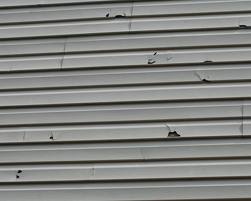What is Hail Damage?
PHASE 1. INITIAL INSPECTION: 888-444-8023
National Storm Damage Center
In many parts of the US, hailstorms are a way of life. For many homeowners it’s not a question of whether a hailstorm will hit, but when damaging hail will hit. Many areas in the U.S. receive hail six or more times a year and many homes are damaged every year. By definition, hail damage is any damage resulting from hailstones and hailstorms. Hailstones that are 0.75 inches or greater are large enough to cause substantial damage to homes, automobiles & property. For comparison, 0.75 inches is the diameter of a penny.
How to Identify Hail Damage
You may think that just because you can’t see any signs of damage, or because your roof isn’t leaking, you don’t have damage. Remember, hail damage can be particularly difficult to identify and many homeowners discover major roofing damage years down the road, after it’s too late to file a storm damage claim with their insurance company. If you have any reason to suspect hail damage after a storm, you should have a full property damage inspection performed by a reputable contractor, right away.  Roof Hail Damage – Roofs are the most commonly damaged part of a home or business in hailstorms. A damaged shingle may allow water to seep through the roof causing additional damage to the roof deck, support structure, interior walls, or windows, and can cause leaking, staining on walls and flooding inside your home. Leaking roofs lead to costly damages and many insurance policies have strict time limits on submitting claims after hailstorms, so it’s in your best interest to act fast after hailstorms and start the repairs process, if necessary.
Roof Hail Damage – Roofs are the most commonly damaged part of a home or business in hailstorms. A damaged shingle may allow water to seep through the roof causing additional damage to the roof deck, support structure, interior walls, or windows, and can cause leaking, staining on walls and flooding inside your home. Leaking roofs lead to costly damages and many insurance policies have strict time limits on submitting claims after hailstorms, so it’s in your best interest to act fast after hailstorms and start the repairs process, if necessary.
- Asphalt Shingle Damage: On an asphalt roof, hail damage looks like a dark spot, or bruise, where the roofing granules have been knocked away (look in gutters for accumulation of granules). In some cases you may find holes, cracking, or missing shingles on roofs with hail damage. This can result in leaking and serious water damage, which can lead to mold formation and wood rot, which can compromise the structural integrity of your roof resulting in collapse. In severe wind storms, it is common for shingles or sections of the roof to be missing altogether.
- Other Types of Shingle Damage: Shake (wood), metal, tile, and slate roof shingles can all suffer damage from hailstorms. Due to the materials, each type of shingle shows unique signs of damage from hail. If shingles are cracked, missing, torn or split at seams, you should definitely have a damage inspection performed. Similarly, if you notice leaking inside your home after a hailstorm, get an inspection right away.
 Siding Damage often results from wind-driven hail. The three most common signs of damage to siding are cracking, chipping and holes. Read more about siding damage here. Window Damage is similar to siding damage, but usually more obvious to identify. Wind-driven hail can strike windows and break the glass itself, or cause damage to the seals on windows. Read more about window damage here. Exterior Appliances can also sustain damage in hailstorms. Denting and intake of excessive amounts of water often affect AC / HVAC units after severe hail. Read more about exterior appliance damage here.
Siding Damage often results from wind-driven hail. The three most common signs of damage to siding are cracking, chipping and holes. Read more about siding damage here. Window Damage is similar to siding damage, but usually more obvious to identify. Wind-driven hail can strike windows and break the glass itself, or cause damage to the seals on windows. Read more about window damage here. Exterior Appliances can also sustain damage in hailstorms. Denting and intake of excessive amounts of water often affect AC / HVAC units after severe hail. Read more about exterior appliance damage here.
How to Repair Hail Damage
Hail damage can be very difficult to detect and often occurs to roofs, siding and windows, all of which are difficult DIY repair projects that could void your homeowners insurance or manufacturer warranty, if not performed by a licensed contractor. Due to the risks associated with hail damage, it is recommended to cut to the chase and have a storm damage repair contractor inspect your damages right away.
American Home Specialists: 888-444-8023
are experts in identifying and repairing hail damage. Contact us and find out how we can help you weather the storm.



